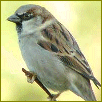House Sparrow depletion: the Thesis |
|
|
The title of my thesis is: "Investigating the causes of the decline of the urban House Sparrow population in Britain". The thesis was published in January 2006 and is available in PDF format via this link Here is the Abstract (see also research summary): In Britain and parts of northwest Europe, House Sparrow Passer domesticus populations have declined markedly in urban-suburban landscapes since the mid-1980s. Little is known about the demographic mechanisms or environmental causes of these population declines, although lack of winter seed has been implicated as a cause of the decline in House Sparrow numbers on farmland. This study focused on factors affecting nesting success and annual productivity of nesting House Sparrows along an urban-suburban-rural gradient centred on the city of Leicester, England. Chick diet (inferred from faecal remains), habitat selection by foraging adults and over-winter survival were also studied. Data were collected during 2001-2003 from 9 study areas spread along the urbanisation gradient. Most sparrows in most study areas nested in or close to domestic gardens. Counts of territorial males declined by 28% between 2001 and 2003, with the largest declines in rural villages (25%) and suburban fringe (16%) and a small increase (4%) in the urban centre. Annual productivity (the estimated number of fledged young/pair/year) was 25% lower in suburban areas and 18% lower in rural areas than that measured during a recent study of farmland House Sparrows in Oxfordshire. The main cause of this lower productivity was starvation of chicks, (usually the first 5-6 days after hatching) during June and July. Chicks were more likely to starve if their diet contained a high proportion of vegetable material (mainly supplementary food) or ants, and less likely to starve if their diet contained a high proportion of spiders. The number of young sparrows successfully fledging, and the aggregate chick biomass, per nesting attempt were greater in home ranges containing relatively high proportions of deciduous shrub, trees and grass, and relatively little concrete. During June and July 2003, more young fledged from home ranges containing a higher density of aphids. Dipteran prey (Tipulids and other flies) constituted a higher proportion of the chick diet in rural localities than in urban-suburban localities, while Homopteran prey (mainly aphids) constituted a higher proportion of chick diet in urban-suburban localities. After allowing for effects of weather, nestling body mass and condition were negatively correlated to local levels of nitrogen dioxide air pollution. Since body mass at fledging is known to be a good predictor of immediate post-fledging survival, I predicted that the lower average body mass at fledging among suburban broods (compared to rural broods) would result in lower survival during the first 10 days after fledging (57% for suburban fledglings, compared to 70% for rural fledglings). The combined effects of lower annual productivity and lower predicted post-fledging survival in suburban localities were large enough to result in rapid predicted population decline, given plausible annual survival rates of adults and first-year sparrows and no net immigration. Under the same set of assumptions, productivity and predicted post-fledging survival were high enough in rural localities to maintain and even increase adult population size. Deciduous shrubbery, grassy areas and concrete were the main summer foraging habitats of suburban and rural House Sparrows, with trees being heavily utilised in 2003. Ornamental and evergreen shrubs were strongly avoided by foraging sparrows. Stable isotope ratios of nitrogen (d15N scores) in chick feathers are proposed to constitute a useful integrated measure of the quality of the chick diet. d15N scores differed markedly between the vegetable (2.7), herbivorous invertebrate (4.7-6.4) and carnivorous invertebrate (7.1-7.7) components of chick diet. d15N scores in sparrow chick feathers averaged 7.7 suggesting that the average d15N score of ingested diet was approximately 4.7 (i.e. was probably dominated by vegetable material and herbivorous invertebrates). Feather d15N scores were lower in home ranges containing relatively large areas of concrete and evergreen vegetation, and were a positive predictor of chick growth rate and body condition. The data presented in this thesis suggest that the abundance of invertebrate prey within home ranges of House Sparrows breeding within suburban and rural garden habitats limits the quantity and quality of chicks raised to fledging. The combined effects of relatively high rates of chick starvation and low body masses at fledging (and consequently low post-fledging survival) observed in suburban localities are large enough to result in rapid population declines. Invertebrate abundance in suburban areas is probably determined, at least in part, by the availability of suitable habitat including native deciduous shrubbery, tress and grassland. Although there is no evidence that the abundance of key invertebrate prey have declined in urban-suburban landscapes, such declines do provide a plausible mechanism for the observed declines in urban-suburban House Sparrow populations. Management techniques, which increase densities of key invertebrate prey during summer, have the potential to increase the annual productivity and possibly the breeding densities of House Sparrows in urban-suburban landscapes. End of Abstract In 2008 further collaborative research: Reproductive success of house sparrows along an urban gradient, was published in the Journal of Animal Conservation |


